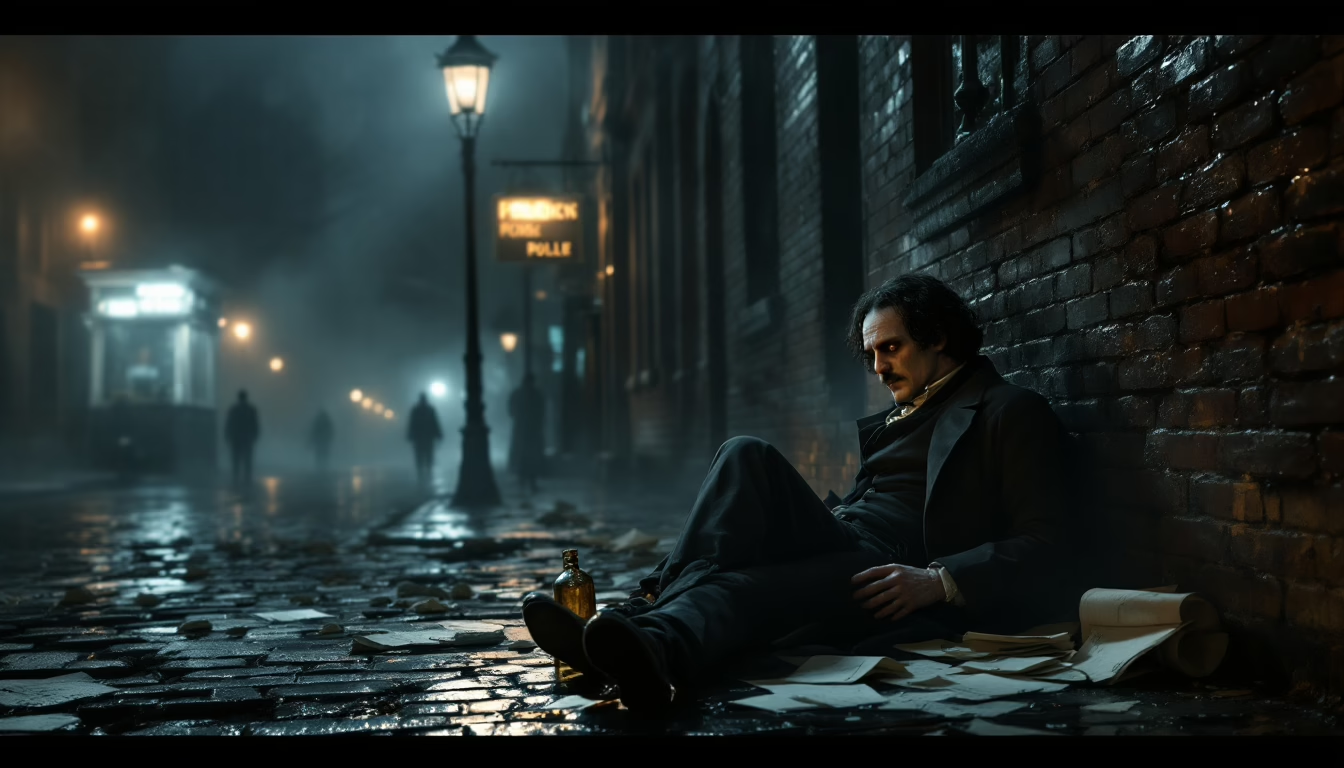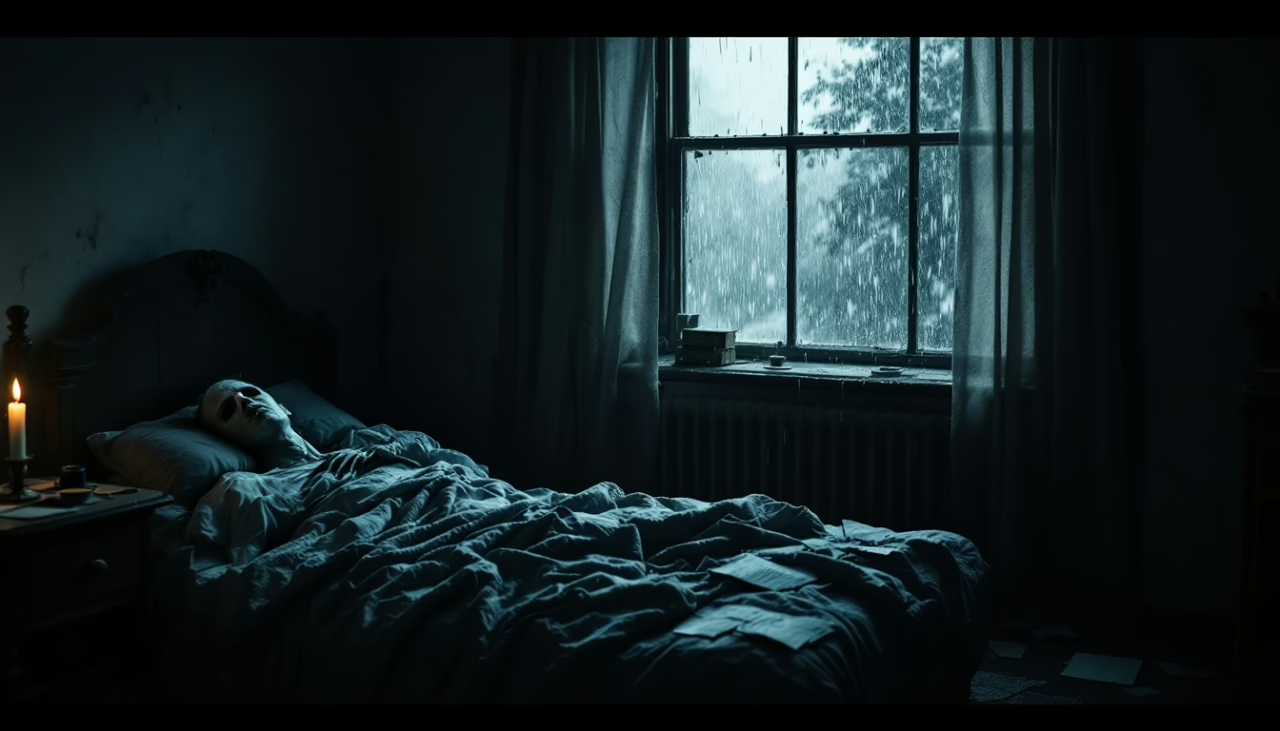The Death of Edgar Allan Poe: Unanswered Riddle

The mysterious demise of Edgar Allan Poe invites both speculation and intrigue. Found in a delirious state, his last moments remain a puzzle. Medical theories abound, yet none provide clarity.
The notion of cooping, a sinister election-day plot, adds a chilling twist.
Compounded by personal tribulations and literary rivalries, Poe’s final days offer a haunting glimpse into his troubled existence. What truly lay behind the curtain of his enigmatic end?
Highlights
Hide- Edgar Allan Poe was found delirious and disheveled in Baltimore on October 3, 1849, leading to his hospitalization for four days.
- Physicians struggled to diagnose Poe's condition, speculating on causes like rabies, fever, cerebral inflammation, and alcohol influence.
- A conspiracy theory suggests Poe was a victim of cooping, forced into corrupt voting practices, but lacks substantial evidence.
- Poe's personal struggles, including grief over Virginia's death and literary rivalries, contributed to his emotional decline before his death.
- His burial was in a pauper's grave, reflecting his financial struggles, with his legacy later honored through memorials recognizing his literary genius.
The Final Days: Edgar Allan Poe’s Last Moments Unraveled

In the shadows of Baltimore, a grim discovery awaited those who stumbled upon Edgar Allan Poe, his frail form abandoned on the streets, a haunting image of despair.
His subsequent four-day hospital stay became a tapestry of mystery, revealing not just the physical deterioration of a literary genius but also the enigma of his final moments.
As whispers of his condition echoed through the halls, the world held its breath, desperate to understand the mind behind the macabre, now teetering on the brink of oblivion.
A Grim Discovery: Found in Baltimore’s Streets
On October 3, 1849, the streets of Baltimore bore witness to a haunting scene as Edgar Allan Poe lay ragged and alone, a specter of his former self.
Eyewitness accounts flooded in, each tinged with confusion and sorrow, recounting the disjointed words that fell from his lips like leaves in the wind.
In the grim twilight of his final moments, the enigma of his demise deepened, leaving a trail of unanswered questions echoing through the shadows of literary history.
Ragged and Alone: The Scene on October 3, 1849
Though the sun had barely risen on October 3, 1849, the streets of Baltimore bore witness to a tragic spectacle—a disheveled figure, Edgar Allan Poe, stumbled through the murky alleys, his once-vibrant imagination seemingly extinguished.
Clad in tattered garments, he evoked a haunting sorrow, a ghost of his former self, as shadows of despair enveloped him, leaving behind whispers of lost brilliance and unfulfilled dreams.
Last Words and Confusion: What Witnesses Saw
Amidst the chaos of that fateful morning, the final moments of Edgar Allan Poe emerged shrouded in a fog of confusion and despair.
Witnesses recounted fragmented whispers and delirious pleas, as his eyes flickered with unfathomable sorrow.
In those haunting seconds, the depths of his tortured soul seemed to unravel, leaving onlookers grappling with the mystery of a life extinguished too soon.
The Hospital Stay: Four Days of Mystery
In the dim confines of his hospital room, Edgar Allan Poe slipped further into an enigmatic decline, each passing hour cloaked in an air of foreboding.
The doctors, bewildered by his deteriorating state, found themselves grasping at shadows, unable to pinpoint the affliction that ravaged the once-vibrant poet.
As whispers of his condition spread, the mystery deepened, leaving a haunting silence that would envelop his final days.
Declining in Silence: Poe’s Condition Worsens
Despair enveloped Edgar Allan Poe as he lay confined to a hospital bed, his once-vibrant spirit now dimmed by an unexplained affliction.
Shadows of confusion and fear danced in his fading eyes, while the world outside continued with indifference.
Each breath became a struggle, a stark reminder of mortality, as he slipped further into an abyss, his genius overshadowed by silence and suffering.
Doctors’ Puzzlement: No Clear Diagnosis
How could a mind so sharp and imaginative be reduced to a mere shell of its former self?
In the dim confines of the hospital, physicians were confounded. Symptoms swirled in a chaotic tapestry, yet no definitive diagnosis emerged.
They pondered fever, delirium, and the specter of madness, while Poe lingered on the brink, a tragic enigma wrapped in the shroud of his own genius.
What Killed the Master of the Macabre?
The enigmatic demise of Edgar Allan Poe invites speculation that dances between shadows of alcohol and the specter of unseen illness.
As whispers of his tumultuous relationship with drink echo through time, medical theories of disease and decay emerge, painting a complex portrait of despair.
What truly conspired to claim the life of the master of the macabre remains a haunting mystery, one that intertwines the fragility of the human condition with the dark allure of his genius.
Alcohol’s Dark Shadow: A Common Theory
The lingering specter of alcohol looms large over the enigmatic demise of Edgar Allan Poe, casting shadows of doubt on the circumstances surrounding his final days.
Was he truly intoxicated, or do the tales of his drinking serve merely as a myth, a narrative crafted by those who struggled to comprehend the depths of his genius?
As historians sift through the evidence, the debate intensifies, revealing not only the man behind the macabre but also the potent influence of his vices.
The Drinking Debate: Was Poe Intoxicated?
Was Edgar Allan Poe’s demise a tragic culmination of genius and vice, or merely the consequence of a life marred by addiction?
The specter of alcohol loomed large in Poe’s world, intertwining with his creativity. Critics argue that his turbulent relationship with drink clouded his judgment, perhaps even hastening his end.
This debate invites contemplation on the interplay of brilliance and self-destruction within the tortured artist.
Evidence or Myth: Examining the Booze Claims
Whispers of alcohol’s influence on Edgar Allan Poe’s final days continue to captivate historians and literary enthusiasts alike.
Theories abound, suggesting that the specter of addiction clouded his last moments.
Yet, concrete evidence remains elusive, leaving a haunting ambiguity.
Was it the bottle or the demons of his mind that ultimately extinguished the master of the macabre?
The truth lingers, tantalizingly out of reach.
Disease and Decay: Medical Possibilities Explored
In the shadowy corridors of medical speculation, Edgar Allan Poe’s enigmatic demise invites scrutiny of the ailments that may have plagued his final days.
Symptoms reminiscent of rabies, alongside a mysterious fever, paint a portrait of a mind ensnared by fevered delusions and physical torment.
Additionally, the possibility of cerebral inflammation beckons, suggesting a sinister interplay of disease and decay that could have ultimately claimed the master of the macabre.
Rabies or Fever: Symptoms That Fit
What unseen affliction could have claimed the life of Edgar Allan Poe, a man whose brilliance in capturing the shadowy recesses of the human psyche was matched only by the enigma of his own demise?
Speculation swirls around symptoms reminiscent of rabies or fever—delirium, agitation, and hallucinations.
Each manifestation raises haunting questions about the true nature of his final descent into darkness.
Brain Trouble: Could Inflammation Be the Key?
Could inflammation have played a sinister role in the demise of Edgar Allan Poe, unraveling the very fabric of his mind?
Neurological inflammation, a silent assassin, could explain the writer’s erratic behavior and hallucinatory visions. As his body succumbed, the brain’s delicate balance faltered, leading to chaos.
This insidious process might have robbed the world of its master of the macabre, leaving only haunting echoes behind.
The Cooping Conspiracy: A Sinister Plot?
Amid the chaos of Election Day, a chilling theory emerged, suggesting that Edgar Allan Poe may have fallen victim to a sinister cooping conspiracy, ensnared by unscrupulous operatives in a political game.
Yet, as the tale unfolds, shadows of doubt linger, raising questions about the veracity of this dark narrative.
In a world where facts and fictions intertwine, the truth of Poe’s final hours remains tantalizingly elusive.
Election Day Chaos: Poe as a Victim
On the chaotic streets of Baltimore during Election Day, Edgar Allan Poe became an unwitting pawn in a dark game known as cooping, where unsuspecting victims were coerced into voting for corrupt candidates.
Clad in ill-fitting garments that hinted at a hasty disguise, Poe’s bewildered appearance raised questions about his true circumstances and the sinister forces at play.
As whispers of a conspiracy lingered in the air, the line between victim and participant blurred, casting a shadow over his final hours.
Forced to the Polls: How Cooping Worked
Although the circumstances surrounding Edgar Allan Poe’s final days remain shrouded in mystery, one theory suggests that he fell victim to a nefarious practice known as cooping, a scheme that exploited vulnerable individuals during election season.
The chilling mechanics included:
- Abduction by thugs
- Forced voting at multiple locations
- Disguise to conceal identity
- Manipulation for political gain
Poe’s plight reflects a darker side of democracy.
Clues in the Clothes: A Disguise Gone Wrong?
The mystery of Edgar Allan Poe’s final hours is further complicated by the unsettling possibility that his attire played a role in his demise.
Witnesses described him in ill-fitting clothes, suggesting he may have been a victim of cooping—a sinister scheme to manipulate voters. His disheveled appearance raises questions: Was this a mere disguise, or a harbinger of chaos that ultimately sealed his fate?
Holes in the Tale: Doubts About the Theory
As whispers of the cooping conspiracy linger in the shadows of Edgar Allan Poe’s tragic demise, the timeline of events raises unsettling questions.
Skeptics point to a lack of concrete evidence, suggesting that the theory may be more folklore than fact.
In unraveling the threads of this sinister plot, a clearer understanding of Poe’s final hours remains tantalizingly just out of reach.
Timing Issues: Does the Story Hold Up?
How does one reconcile the eerie circumstances surrounding Edgar Allan Poe’s demise with the timeline of events leading up to that fateful night?
Consider these unsettling markers:
- A mysterious illness gripping him.
- The uncanny sightings of Poe in peculiar states.
- The shadowy figures allegedly involved.
- The haunting whispers of cooping.
Each element intertwines, casting doubt on the veracity of the tale and leaving the truth shrouded in darkness.
Lack of Proof: Why Some Dismiss Cooping
While many enthusiasts of Edgar Allan Poe’s tragic end are captivated by the cooping theory, skepticism looms large, fueled by a conspicuous lack of concrete evidence.
Critics argue that the absence of eyewitness accounts and corroborating details weakens the narrative. This ambiguity invites doubt, leaving the theory as an alluring but unsubstantiated tale, overshadowed by the elusive truth of Poe’s final hours.
Poe’s Enemies and Personal Struggles
Amidst the shadows of literary rivalry, Edgar Allan Poe navigated a treacherous landscape fraught with jealousy and animosity, where revenge may have lingered as a whispered motive.
Haunted by profound grief and the relentless specter of loss, his personal struggles etched deep lines into his troubled existence, shaping his art and psyche.
These intertwined adversities not only marked his life but also foreshadowed the tragic demise of a genius ensnared by the very darkness he so vividly portrayed.
Literary Rivals: Did Revenge Play a Role?
In the shadowy corridors of literary ambition, Edgar Allan Poe found himself ensnared by a web of rivalries that left scars deeper than any ink could convey.
As he navigated the treacherous waters of envy and disdain, questions arose about whether his untimely demise might have been hastened by those he had offended.
With suspicion lingering like a ghost, the complex tapestry of his relationships invites scrutiny into the darker motives that may have shaped his fate.
Feuds and Foes: Poe’s Tangled Relationships
Edgar Allan Poe’s life was marked by a series of tumultuous relationships that often blurred the lines between friendship and rivalry.
His entangled interactions can be summarized as:
- Bitter exchanges with literary critics.
- Jealousy-fueled disputes with fellow authors.
- Fragmented alliances with publishers.
- Heart-wrenching betrayals within personal circles.
These tensions fueled his genius but also deepened his isolation, shaping a legacy rife with conflict.
A Targeted End? Suspicion Lingers
The shadows of Edgar Allan Poe’s tumultuous relationships stretch ominously into the circumstances surrounding his death, raising questions that haunt literary circles to this day.
Rivalries festered among contemporaries, some even whispering of revenge. As jealousy simmered, could adversaries have conspired against him?
The intrigue deepens, transforming his tragic demise into a tapestry of suspicion, where the line between genius and enmity blurs unsettlingly.
Broken Man: Grief and Loss in Poe’s Life
The death of Virginia Poe marked a profound rupture in Edgar Allan Poe’s already fragile existence, leaving him adrift in a sea of sorrow.
This devastating loss not only shattered his spirit but also propelled him into a wandering despair that mirrored the tumultuous landscapes of his literary works.
As he navigated the streets of Baltimore, the specter of grief loomed large, shaping both his personal struggles and his artistic vision.
Virginia’s Death: A Blow to His Spirit
Grief enveloped Edgar Allan Poe like a shroud, darkening the already tumultuous landscape of his life. Virginia’s death shattered his spirit, leaving him to navigate a world now bereft of light.
In her absence, he felt:
- The cold embrace of despair.
- The haunting echoes of lost laughter.
- The weight of unfulfilled dreams.
- The relentless specter of solitude.
Wandering and Despair: The Path to Baltimore
Haunted by the void left in Virginia’s wake, Edgar Allan Poe set out on a precarious journey to Baltimore, a city that would become both a refuge and a prison for his tortured soul.
Despair clung to him like a shroud, as he wandered the streets, seeking solace yet finding only shadows.
Each step echoed with memories of loss, deepening his melancholic narrative.
The Legacy of an Unsolved End
Edgar Allan Poe’s burial, marked by haste and obscurity, serves as a haunting metaphor for the unresolved mysteries that surrounded his life and death.
This quiet farewell, shrouded in enigma, invites a relentless curiosity that continues to captivate scholars and enthusiasts alike.
The lingering questions about his final moments echo through time, ensuring that Poe’s legacy remains as complex and unresolved as his own narrative.
Burial in Haste: Poe’s Quiet Farewell
In the shadow of tragedy, Edgar Allan Poe was laid to rest in a pauper’s grave, a stark reflection of the life he led, marked by financial struggles and personal despair.
This hasty burial, devoid of ceremony, belied the profound impact his words would eventually wield, igniting a legacy that demanded recognition.
Over time, monuments would rise to honor the lost poet, transforming a quiet farewell into a tribute of enduring influence and unresolved mysteries that continue to haunt literary circles.
A Pauper’s Grave: The Initial Resting Place
Amidst the somber shadows of Baltimore’s Westminster Hall, an unremarkable grave marked the final resting place of a literary genius whose life had been equally enigmatic and tumultuous.
- A weathered stone, barely distinguishable.
- Sparse earth, unadorned and plain.
- Surrounding silence, echoing lost words.
- Faint whispers of a haunting legacy.
In this humble setting, Poe’s spirit lingered, forever entwined with the mystery of his untimely demise.
Monuments Later: Honoring the Lost Poet
The shadow of Edgar Allan Poe’s unceremonious burial soon gave way to a profound recognition of his literary contributions, prompting a wave of memorials that sought to honor the complexities of his life and the mystery surrounding his death.
These monuments, often adorned with poignant inscriptions, emerged as beacons of reverence, celebrating a genius whose haunting narratives continue to resonate, inviting reflection and exploration of the human condition.
Why We Still Wonder: Poe’s Death Endures
The enigma surrounding Edgar Allan Poe’s death continues to captivate imaginations, intertwining fact and fiction in a tapestry rich with mystery.
As whispers of his final moments echo through the corridors of literary history, the line between the man and the myth blurs, inviting both scholars and enthusiasts to ponder the deeper truths behind his untimely demise.
In this exploration, the haunting legacy of an unresolved ending reveals not only the complexities of Poe’s life but also the enduring power of storytelling itself.
Stories That Live On: Fiction Meets Fact
Though the circumstances surrounding Edgar Allan Poe’s death remain shrouded in mystery, they have sparked a myriad of theories and narratives that continue to captivate the imagination.
These stories intertwine fiction with fact, inviting exploration of:
- The haunting final hours.
- The specter of alcoholism.
- The whispers of conspiracy.
- The enigma of his lost works.
Such elements guarantee Poe’s legacy thrives in perpetual intrigue.
The Man and the Myth: Poe’s Lasting Echo
Mystery cloaks the final moments of Edgar Allan Poe’s life, transforming the man into a myth that endures through the ages.
His enigmatic demise fuels speculation, inviting interpretations that traverse the domains of genius and madness.
Each retelling adds layers to his legacy, enthralling those who seek to unravel the riddle of mortality, artistry, and the shadows that linger in the human soul.
Wrapping Up
In the shadowy abyss of history, Edgar Allan Poe’s death stands as an enigma that tantalizes the imagination, a haunting specter of what might have been.
As whispers of conspiracy and betrayal swirl like the mists of a midnight graveyard, the truth remains just beyond grasp, a ghostly silhouette in the fog of time.
His tragic end, steeped in sorrow and shrouded in intrigue, forever entwines his tortured genius with the very essence of literary immortality, leaving hearts yearning for answers unfulfilled.





